Power Controllable LED System with Increased Energy Efficiency Using Multi-Sensors for Plant Cultivation
Abstract
:1. Introduction
2. Background
3. Proposed Adaptive LED Control Method
3.1. Illuminance to PPFD Conversion
3.2. Inverse Square Law
3.3. PPFD Consideration
3.4. Optimal PWM Determination
4. Hardware Implementation
5. Experiment Result
5.1. Power Model
5.2. Power Consumption Evaluation
6. Conclusions
Acknowledgments
Author Contributions
Conflicts of Interest
References
- Baldos, U.L.C.; Hertel, T.W. Global food security in 2050: The role of agricultural productivity and climate change. Aust. J. Agric. Resour. Econ. 2014, 58, 554–570. [Google Scholar] [CrossRef]
- Poulet, L.; Massa, G.D.; Morrow, R.C.; Bourget, C.M.; Wheeler, R.M.; Mitchell, C.A. Significant reduction in energy for plant-growth lighting in space using targeted LED lighting and spectral manipulation. Life Sci. Space Res. 2014, 2, 43–53. [Google Scholar] [CrossRef]
- Reith, J.H.; Deurwaarder, E.P.; Hemmes, K.; Curvers, A.; Kamermans, P.; Brandenburg, W.A.; Lettings, G. Bio-Offshore: Grootschalige Teelt Van Zeewieren in Combinatie Met Offshore Windparken in de Noordzee. Available online: https://www.ecn.nl/publications/ECN-C--05-008 (accessed on 13 February 2017).
- Bourget, C.M. An introduction to light-emitting diodes. HortScience 2008, 43, 1944–1946. [Google Scholar]
- Morimoto, T.; Torii, T.; Hashimoto, Y. Optimal control of physiological processes of plants in a green plant factory. Control Eng. Pract. 1995, 3, 505–511. [Google Scholar] [CrossRef]
- Morrow, R.C. LED lighting in horticulture. HortScience 2008, 43, 1947–1950. [Google Scholar]
- Li, Q.; Kubota, C. Effects of supplemental light quality on growth and phytochemicals of baby leaf lettuce. Environ. Exp. Bot. 2009, 67, 59–64. [Google Scholar] [CrossRef]
- Mizuno, T.; Amaki, W.; Watanabe, H. Effects of monochromatic light irradiation by LED on the growth and anthocyanin contents in leaves of cabbage seedlings. In Proceedings of the VI International Symposium on Light in Horticulture, Tsukuba, Japan, 15–19 November 2009. [Google Scholar]
- Samuolienė, G.; Urbonavičiūtė, A.; Duchovskis, P.; Bliznikas, Z.; Vitta, P.; Žukauskas, A. Decrease in nitrate concentration in leafy vegetables under a solid-state illuminator. HortScience 2009, 44, 1857–1860. [Google Scholar]
- Stutte, G.W.; Edney, S.; Skerritt, T. Photoregulation of bioprotectant content of red leaf lettuce with light-emitting diodes. HortScience 2009, 44, 79–82. [Google Scholar]
- Tarakanov, I.; Yakovleva, O.; Konovalova, I.; Paliutina, G.; Anisimov, A. Light-emitting diodes: on the way to combinatorial lighting technologies for basic research and crop production. In Proceedings of the VII International Symposium on Light in Horticultural Systems, Wageningen, The Netherlands, 15–18 October 2012. [Google Scholar]
- Nanya, K.; Ishigami, Y.; Hikosaka, S.; Goto, E. Effects of blue and red light on stem elongation and flowering of tomato seedlings. In Proceedings of the VII International Symposium on Light in Horticultural Systems, Wageningen, The Netherlands, 15–18 October 2012. [Google Scholar]
- Bliznikas, Z.; Žukauskas, A.; Samuoliene, G.; Viršile, A.; Brazaityte, A.; Jankauskiene, J.; Duchovskis, P.; Novičkovas, A. Effect of supplementary pre-harvest LED lighting on the antioxidant and nutritional properties of green vegetables. Acta Hortic. 2012, 939, 85–91. [Google Scholar] [CrossRef]
- Samuolienė, G.; Sirtautas, R.; Brazaitytė, A.; Viršilė, A.; Duchovskis, P. Supplementary red-LED lighting and the changes in phytochemical content of two baby leaf lettuce varieties during three seasons. J. Food Agric. Environ. 2012, 10, 701–706. [Google Scholar]
- Furuyama, S.; Ishigami, Y.; Hikosaka, S.; Goto, E. Effects of blue/red ratio and light intensity on photomorphogenesis and photosynthesis of red leaf lettuce. Acta Hortic. 2014, 1037, 317–322. [Google Scholar] [CrossRef]
- Heo, J.W.; Lee, Y.B.; Kim, D.E.; Chang, Y.S.; Chun, C. Effects of supplementary LED lighting on growth and biochemical parameters in dieffenbachia amoena ‘Camella’ and Ficus elastica ‘Melany’. Korean J. Hortic. Sci. Technol. 2010, 28, 51–58. [Google Scholar]
- Meng, P.; Ge, Y.; Cao, Q.; Chang, J.; Pan, P.; Liu, C.; Lu, Y.; Chang, S.X. Growth and photosynthetic responses of three Lycoris species to levels of irradiance. HortScience 2008, 43, 134–137. [Google Scholar]
- Olvera-Gonzalez, E.; Alaniz-Lumbreras, D.; Ivanov-Tsonchev, R.; Villa-Hernández, J.; Olvera-Olvera, C.; González-Ramírez, E.; Araiza-Esquivel, M.; Torres-Argüelles, V.; Castaño, V. Intelligent lighting system for plant growth and development. Comput. Electron. Agric. 2013, 92, 48–53. [Google Scholar] [CrossRef]
- Choi, H.G.; Moon, B.Y.; Kang, N.J. Effects of LED light on the production of strawberry during cultivation in a plastic greenhouse and in a growth chamber. Sci. Hortic. 2015, 189, 22–31. [Google Scholar] [CrossRef]
- Folta, K.M.; Childers, K.S. Light as a growth regulator: Controlling plant biology with narrow-bandwidth solid-state lighting systems. HortScience 2008, 43, 1957–1964. [Google Scholar]
- Burattini, C.; Mattoni, B.; Bisegna, F. The impact of spectral composition of white LEDs on spinach (Spinacia oleracea) Growth and Development. Energies 2017, 10, 1383. [Google Scholar] [CrossRef]
- Tai, W.-C.; Tseng, Y.-C.; Chiang, I.-T.; Lin, Y.-S.; Chung, W.-Y.; Wu, K.-W.; Yeh, Y.-H. Development of a multi-parameter plant growth monitoring and control system for quality agriculture application. In Proceedings of the 2017 International Conference on Applied System Innovation, Sapporo, Japan, 13–17 May 2017. [Google Scholar]
- Centobelli, P.; Cerchione, R.; Esposito, E. Environmental sustainability in the service industry of transportation and logistics service providers: Systematic literature review and research directions. Transp. Res. Part Transp. Environ. 2017, 53, 454–470. [Google Scholar] [CrossRef]
- Rajeev, A.; Pati, R.K.; Padhi, S.S.; Govindan, K. Evolution of sustainability in supply chain management: A literature review. J. Clean. Prod. 2017, 162, 299–314. [Google Scholar] [CrossRef]
- Correia, E.; Carvalho, H.; Azevedo, S.G.; Govindan, K. Maturity models in supply chain sustainability: A Systematic Literature Review. Sustainability 2017, 9, 64. [Google Scholar] [CrossRef]
- Lee, S.; Park, S. Energy savings of home growing plants by using daylight and LED. In Proceedings of the Sensors Applications Symposium, Galveston, TX, USA, 19–21 February 2013. [Google Scholar]
- Liao, M.; Wang, L.; Yang, R.; Gong, M. Light fall-off stereo. In Proceedings of the IEEE Conference on Computer Vision and Pattern Recognition, Minneapolis, MI, USA, 17–22 June 2007. [Google Scholar]
- Lan, L.; Tan, Y.K. Advanced building energy monitoring using wireless sensor integrated Energy Plus platform for personal climate control. In Proceedings of the 2015 IEEE 11th International Conference on Power Electronics and Drive Systems (PEDS), Sydney, Australia, 9–12 June 2015; pp. 567–574. [Google Scholar]
- Nhí, P.N.; Ba, T.T.; Thúc, L.V.; Long, P.N.; Non, T.T.S.; Thủy, V.T.B. Effects of color LED light intensities and different photoperiod regimes on growth of hydroponic lettuce. Can Tho Univ. J. Sci. 2016, 2, 1–7. [Google Scholar]
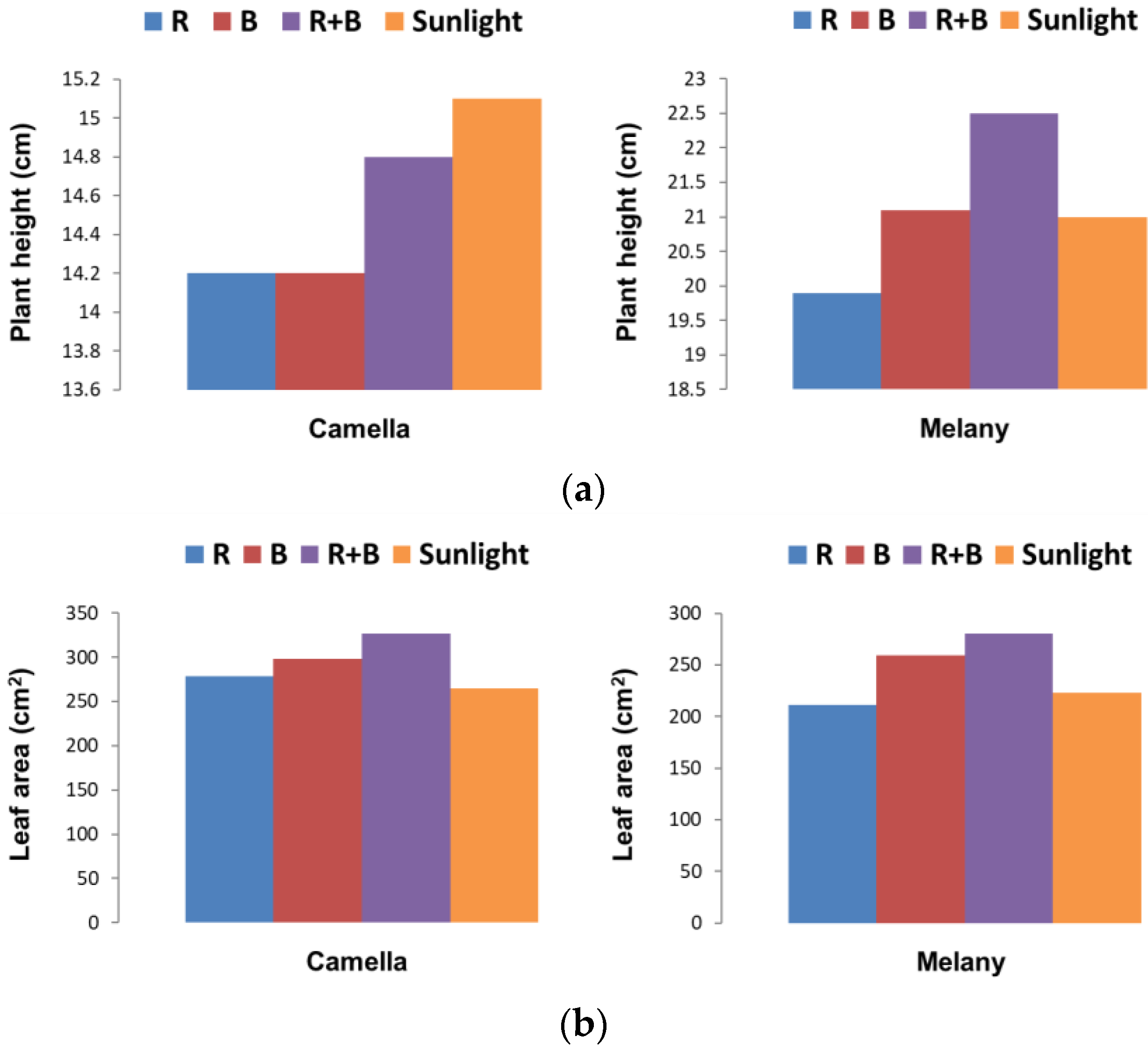


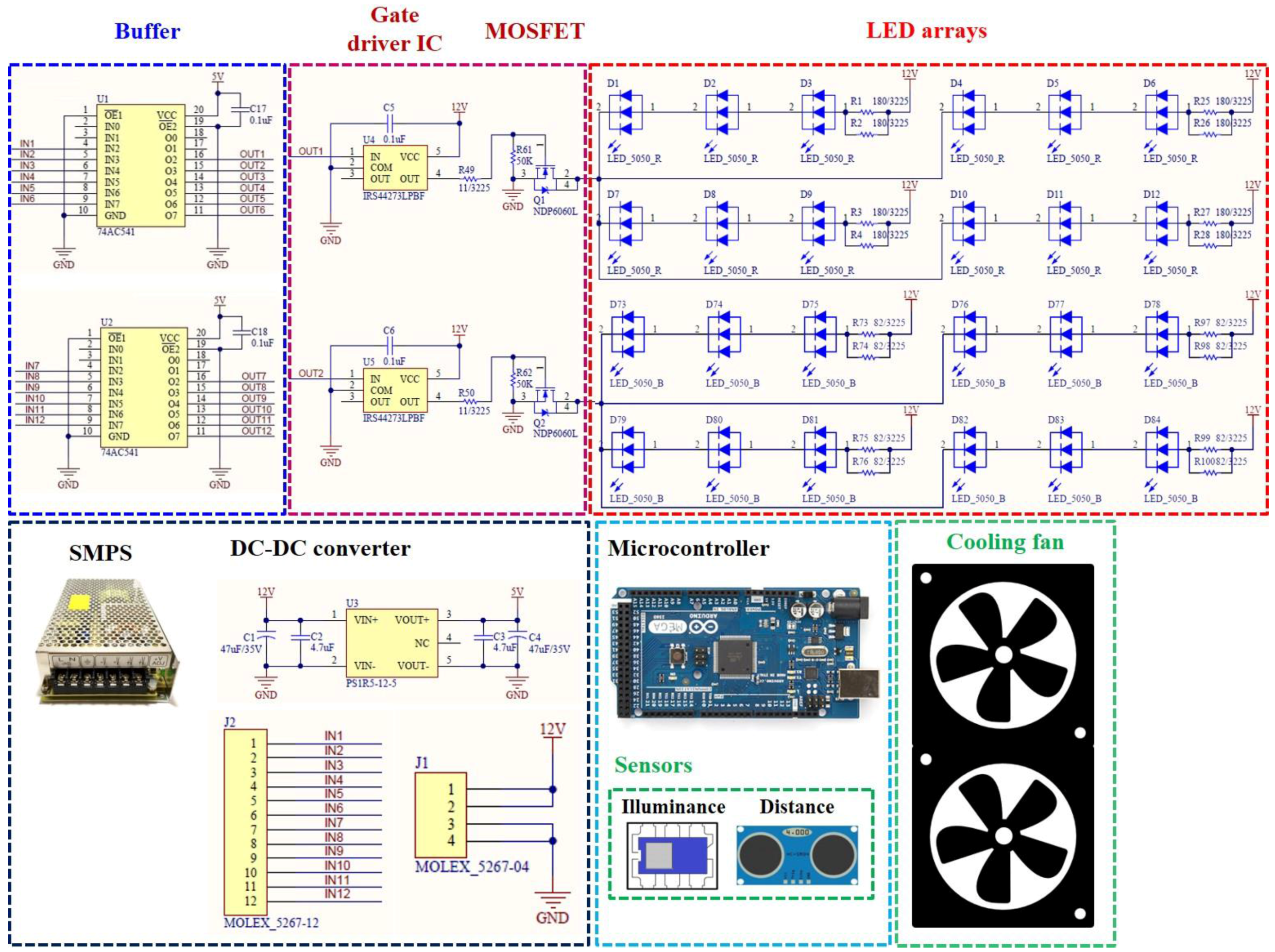
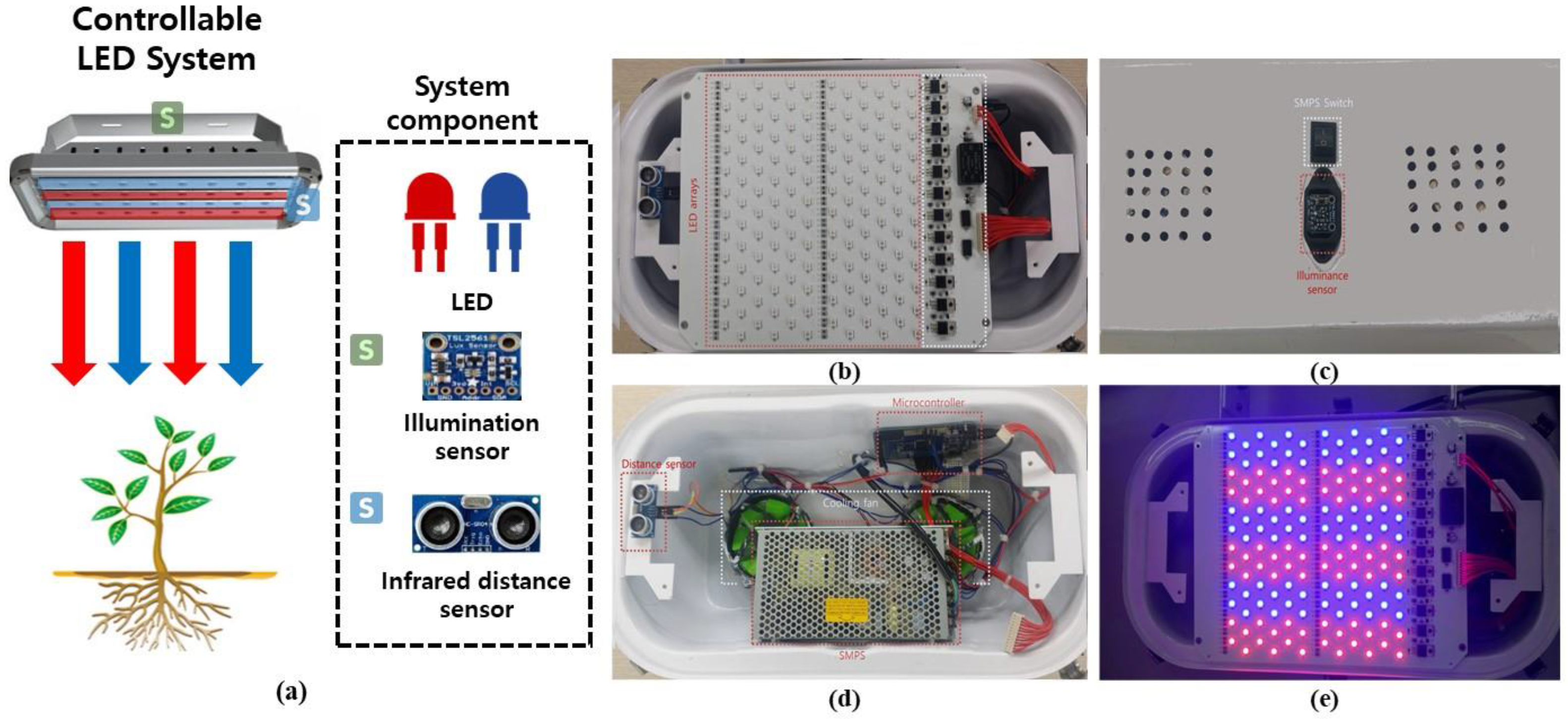
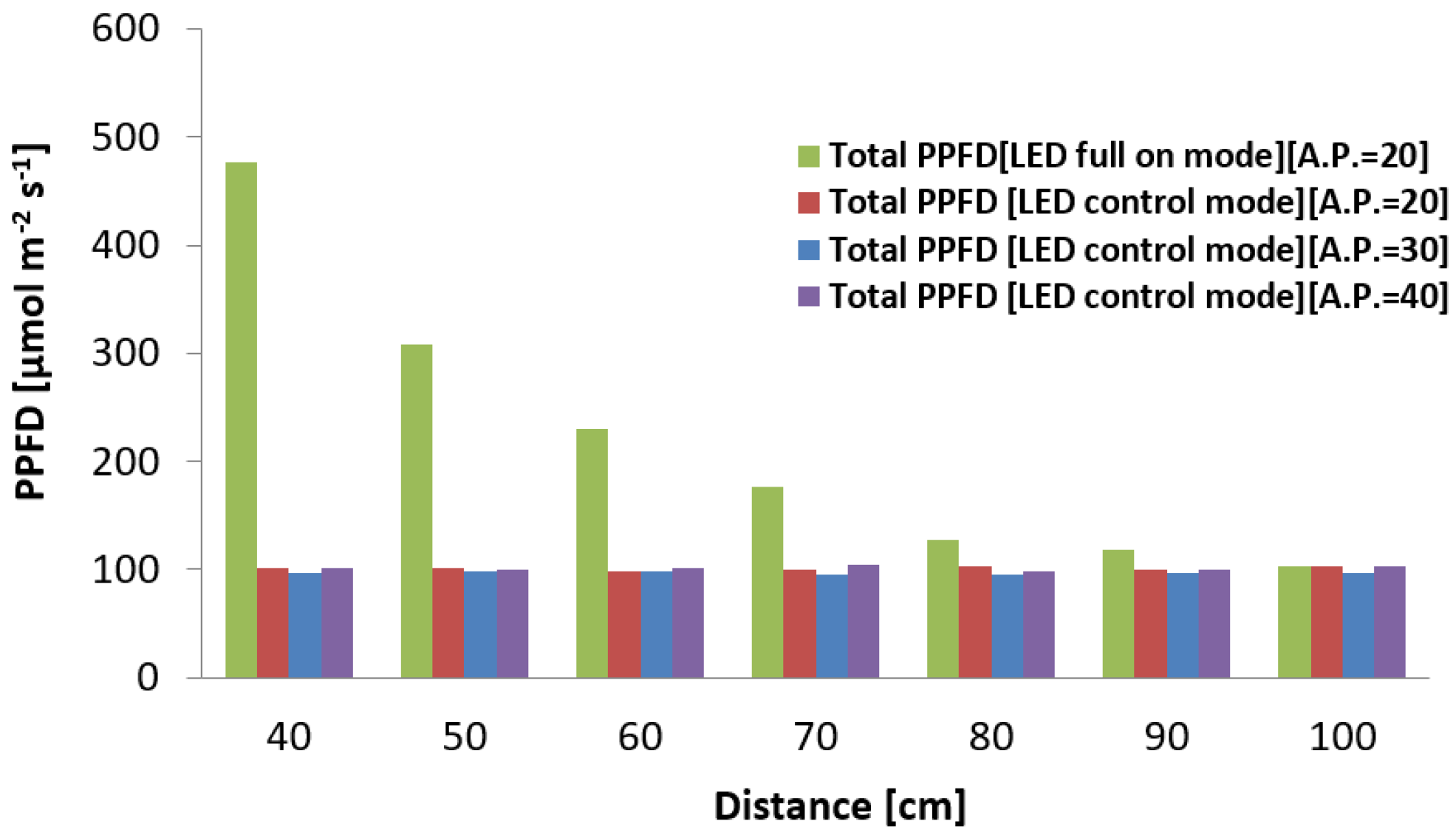
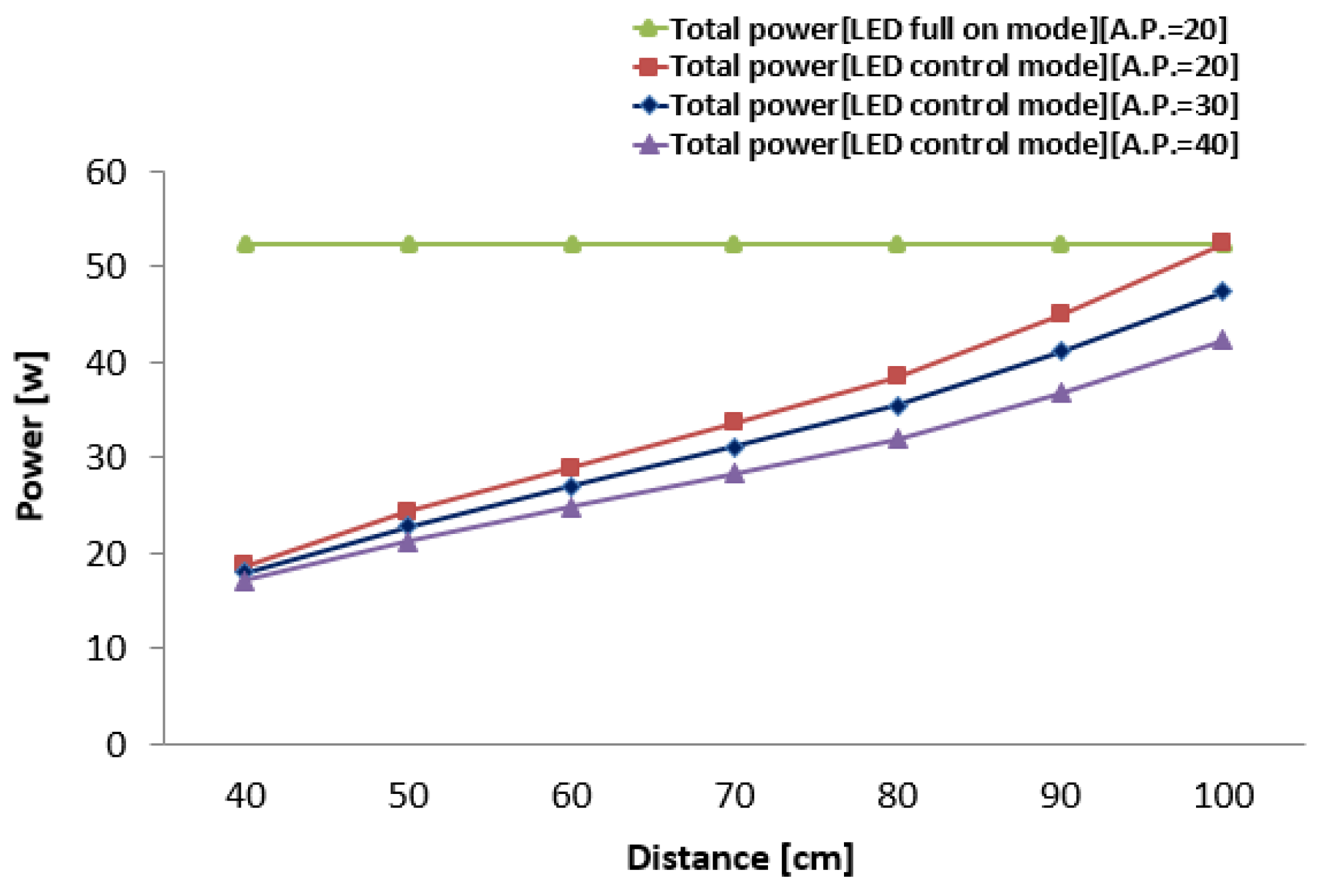

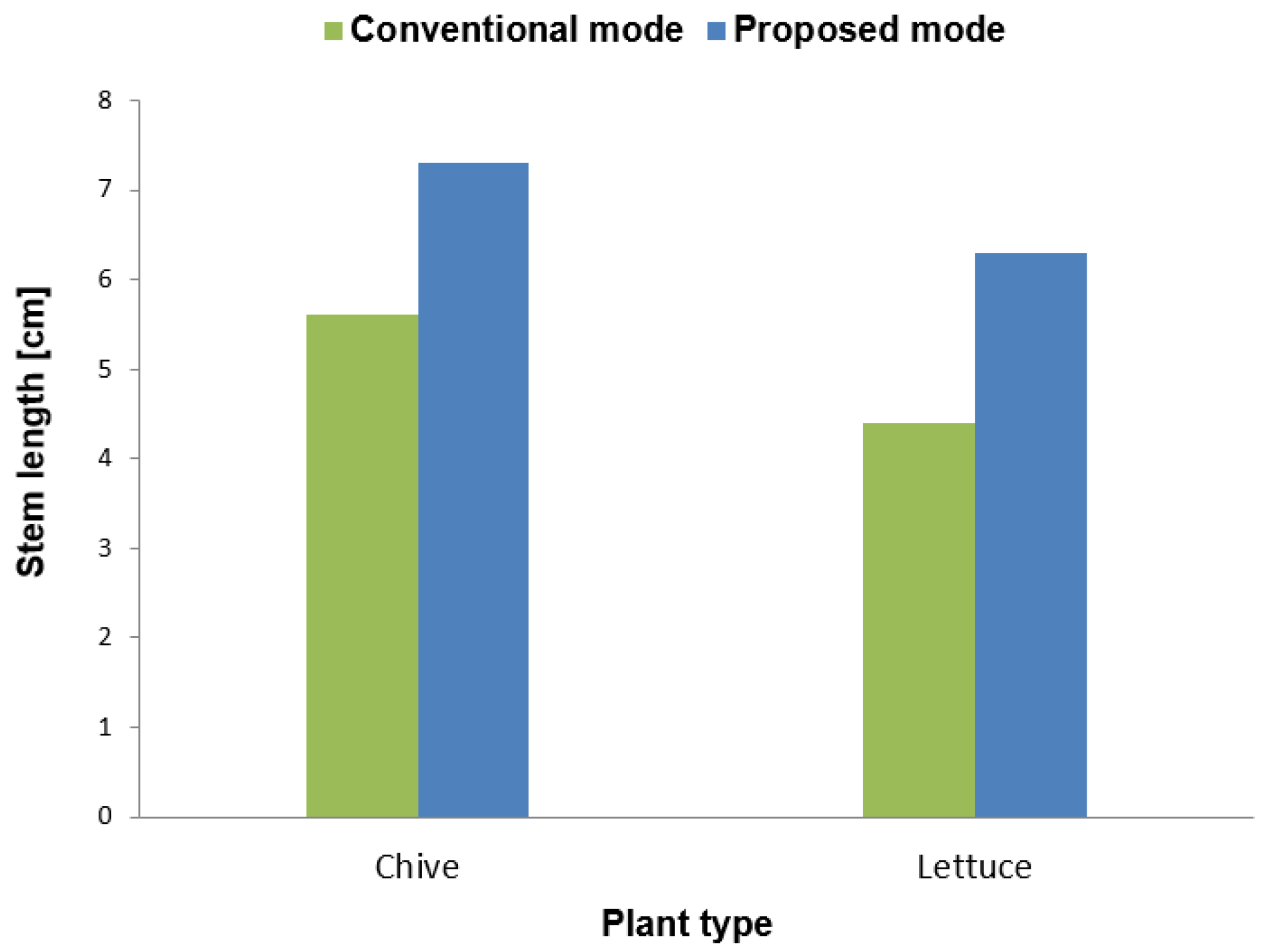
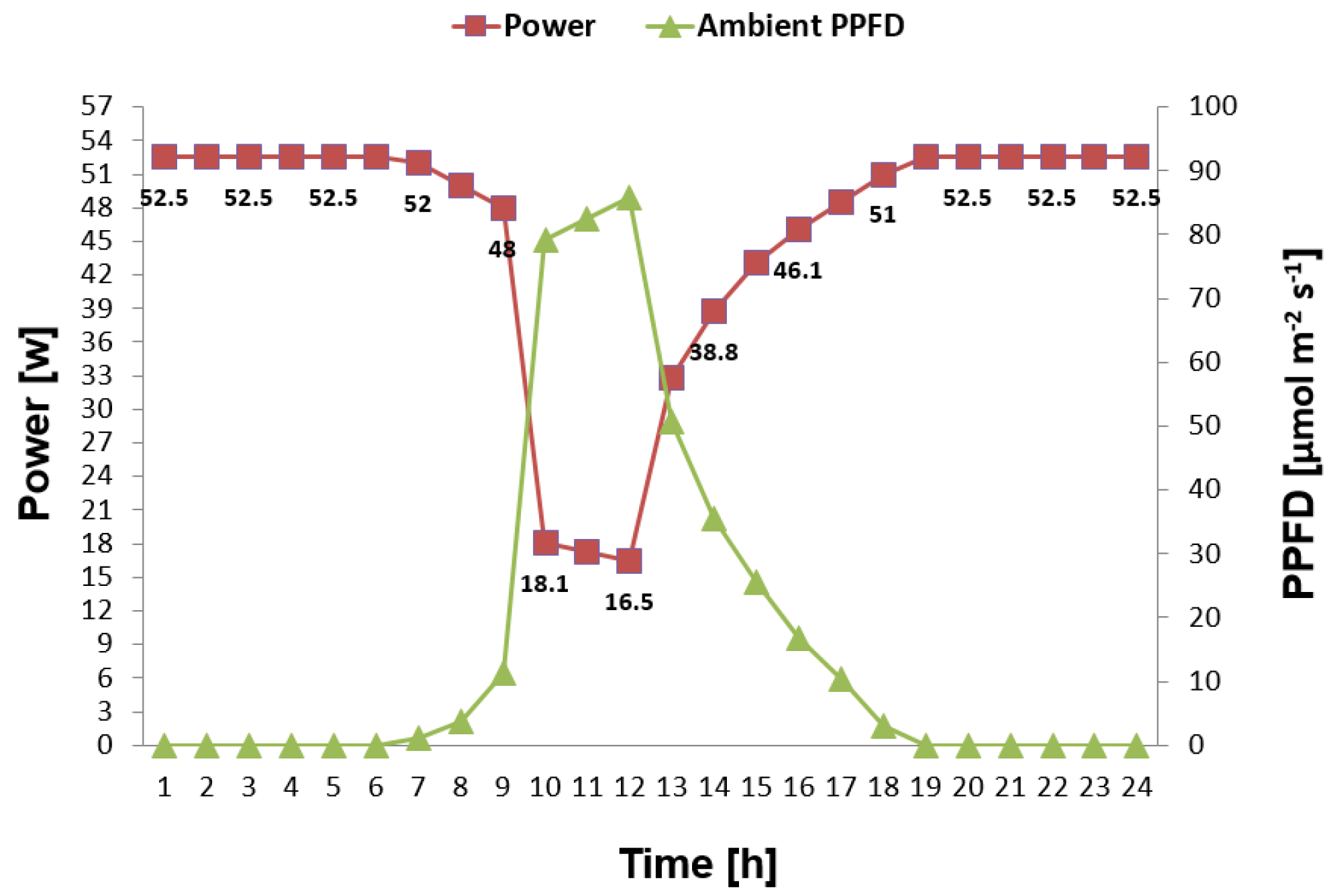
| Reference | Plant | Light Source | Effect on Plant |
|---|---|---|---|
| [7] | Baby lettuce | Red LEDs (658 nm) | Increase of phenolics concentration |
| Baby lettuce | Blue LEDs (476 nm) | Increase of anthocyanin and carotenoids | |
| [8] | Cabbage | Red LEDs (660 nm) | Increase of anthocyanin content |
| Cabbage | Blue LEDs (470 nm) | Higher chlorophyll content promotion petiole elongation | |
| [9] | Lettuce, Green onions | Red LEDs (638 nm) Natural illumination | Reduction of nitrate content |
| [10] | Red leaf lettuce | Red LEDs (640 nm); Blue LEDs (440 nm) | Increase of anthocyanin content, antioxidant potential and total leaf area |
| [11] | Indian mustard, Basil | Red LEDs (660 and 635 nm); Blue LEDs (460 nm) | Delay in plant transition to flowering |
| [12] | Tomato seedlings | Red LEDs (660 nm); Blue LEDs (450 nm) | Reduction of stem length |
| Reference | Plant | Light Source | PPFD (μmol m−2·s−1) | Effect on Plant |
|---|---|---|---|---|
| [10] | Red leaf lettuce | Red LEDs (640nm); Blue LEDs(440nm) | LED: 300 | Increase of anthocyanin content, antioxidant potential and leaf area |
| [13] | Mustard, Spinach | Red LEDs (638nm) and HPS lamp | Total: 300 | Increase of vitamin C content |
| [14] | Baby lettuce | Red LEDs (638nm) and HPS lamp | LED: 210 | Increase of phenolics, tocopherols, antioxidant capacity, sugars |
| HPS: 300 | ||||
| [15] | Lettuce | Red LEDs (660nm); Blue LEDs(450nm) | LED: 100 | Increase of total dry weight |
| LED: 200 | ||||
| LED: 300 |
| Light Source | Sunlight | Incandescent | Fluorescent Lamp | Red LED | Blue LED |
|---|---|---|---|---|---|
| Conversion factor | 54.0 | 50.0 | 74.0 | 9.9 | 11.9 |
| Ambient PPFD (μmol m−2 s−1) | Distance (cm) | Conventional System | Proposed System | ||||
|---|---|---|---|---|---|---|---|
| PWM | Power (W) | Total PPFD (μmol m−2 s−1) | PWM | Power (W) | Total PPFD (μmol m−2 s−1) | ||
| 20 | 100 | 255 | 52.5 | 101 | 255 | 52.5 | 101 |
| 80 | 255 | 52.5 | 127 | 140 | 34 | 102 | |
| 60 | 255 | 52.5 | 230 | 110 | 28.9 | 99 | |
| 40 | 255 | 52.5 | 476 | 45 | 18.7 | 101 | |
| 30 | 100 | 255 | 52.5 | 111 | 223 | 47.4 | 97 |
| 80 | 255 | 52.5 | 137 | 122 | 31.1 | 95 | |
| 60 | 255 | 52.5 | 240 | 96 | 27 | 98 | |
| 40 | 255 | 52.5 | 486 | 39 | 18 | 97 | |
| 40 | 100 | 255 | 52.5 | 121 | 191 | 42.3 | 102 |
| 80 | 255 | 52.5 | 147 | 105 | 28.4 | 98 | |
| 60 | 255 | 52.5 | 250 | 82 | 24.7 | 101 | |
| 40 | 255 | 52.5 | 496 | 33 | 17 | 101 | |
© 2017 by the authors. Licensee MDPI, Basel, Switzerland. This article is an open access article distributed under the terms and conditions of the Creative Commons Attribution (CC BY) license (http://creativecommons.org/licenses/by/4.0/).
Share and Cite
Ahn, Y.D.; Bae, S.; Kang, S.-J. Power Controllable LED System with Increased Energy Efficiency Using Multi-Sensors for Plant Cultivation. Energies 2017, 10, 1607. https://doi.org/10.3390/en10101607
Ahn YD, Bae S, Kang S-J. Power Controllable LED System with Increased Energy Efficiency Using Multi-Sensors for Plant Cultivation. Energies. 2017; 10(10):1607. https://doi.org/10.3390/en10101607
Chicago/Turabian StyleAhn, Yong Deok, Sungwoo Bae, and Suk-Ju Kang. 2017. "Power Controllable LED System with Increased Energy Efficiency Using Multi-Sensors for Plant Cultivation" Energies 10, no. 10: 1607. https://doi.org/10.3390/en10101607






